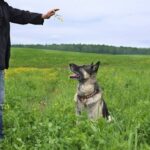Introduction
Understanding English words and commands is essential for training dogs properly. Effective dog training requires consistency in word choice and command delivery. Dogs must learn the meaning of certain words as related to obedience in order to respond quickly and reliably to their owners’ commands. Dogs are eager learners, but they must be taught appropriate behavior with the right words—and that’s where the power of language comes in. With clear verbal directions, pets can learn a variety of behaviors such as coming when called, important safety cues like “stop,” and how to socialize correctly with other people or animals. The words used during training should be kept consistent so that animals know what they’re expected of them at all times; this ensures positive results more quickly and efficiently than using different words every time. The right combination of patient instruction, positive reinforcement, and English language knowledge can result in a well-trained, obedient dog!
Popular Dog Training Terminology
Backup Command: Backup is a command used to tell the dog to move their body backwards or away from something. This command helps in situations where your pup is getting too close to someone or something they should not be near.
Sit: Sit is a verbal order that tells a pup to assume a sitting position. It can be used as part of commands or on its own as an obedience exercise.
Stay/Wait: Stay and wait are both commands used to tell a dog not to move from their current location until released by their handler.
Come: Come, also known as the recall command, is the order used to get your pup to come towards you from any distance.
Heel: Heel is a command used when teaching your dog basic leash etiquette. It instructs them that they need to remain at heel with the handler while walking without pulling on the leash.
Release/Free/Break: Release, free and break are all terms for telling your pup that it can now relax and stop performing whatever action it was previously doing, such as sitting still or giving paw.
Gaining Attention
When working with a dog, it is important to capture their attention and keep it for an extended period of time. This can be done by using your eyes, ears and verbal commands. When you initially start training your dog, make sure to scan the environment so that there are no distractions— like other animals, people or food — that could take the focus away from your commands. Maintain direct eye contact with the animal so they understand that you are speaking to them and not someone else. It also helps build trust between you and your dog.
In addition to maintaining eye contact, use vocal commands in a steady and confident tone of voice so that the dog understands what you’re saying to them clearly. Always remember that although a higher pitched or excited voice may catch their attention quickly, it might also confuse them because they will not be able to interpret your words and this may hinder training progress. Finally, monitor their physical responses such as pointing of their ears, raising of hackles or cowering downwards which can give an indication of how scared or alert they are during training sessions.
Different Commands for Different Behaviors
One of the most important aspects of dog training is using different commands for different behaviors. By training your dog to understand specific commands, you can elicit specific behavior from them. For example, using the command “sit” will usually prompt your dog to sit down on command, while using the word “heel” will usually result in them walking beside you as you move about. Other useful words for teaching your dog include “come” and “stay”; with ‘come’, your pet will come running when called upon and ‘stay’ instructs them to remain in place until recalled. Additionally, a common marker word such as ‘yes’ or ‘good’ is often recommended to reinforce desired behavior by letting the animal know they have done something correctly—this technique may be employed following obedience commands or other tasks. Ultimately, by creating a set of relevant words and by consistently associating them with specific behaviors, you will be able to quickly communicate what you want your pet to do—resulting in effective and efficient dog training sessions!
Using Positive Reinforcement
Positive reinforcement in dog training is a key component for successful behavior modification. As opposed to using punishment for undesirable behavior, positive reinforcement encourages behaviors that are desirable, with the aim of modifying the dog’s future responses. Positive reinforcement works by rewarding your pup after they have responded correctly or in the desired way to reinforcement cues such as verbal commands or hand signals. For example, if you give the verbal command “sit” and your pup complies with this command right away, you can reward them with treats, praise, petting or playtime. This creates a positive learning experience and allows your pup to build confidence as they learn new associations; associating doing as commanded leads to pleasant experiences. Whenever possible, introduce positive reinforcement during training sessions to help foster understanding while keeping the process both safe and enjoyable for both you and your pup.
Consistency is Crucial
Consistency is essential in dog training as it helps to create a clear and understandable routine for the dog. It reinforces behaviours that have been learnt and helps to discourage unwanted behaviours. When commands are given inconsistently, it can become confusing for a dog and they will develop confusion or even an inability to understand what is expected of them in certain situations. Consistency also encourages faster learning because the same instructions will be followed each time, allowing the dog to remember the command with greater ease. Additionally, through consistent practice, dogs begin to understand more complex commands. Therefore, consistency is crucial in order for a dog to learn quickly and effectively.
Observe and Understand
Observing and understanding your dog is essential for creating a strong, healthy bond. It’s important to take note of their body language and facial expressions as a means of gauging their emotions and behavior. Take the time to watch your dog move, observe their mannerisms, and pick up on habits they may have developed over time. Through this kind of observation you can identify their preferences and gain deeper insight into the way they think. Once you better understand your canine companion, you’ll be able to use effective techniques to train them according to their individual needs. Some specific techniques that help build on this knowledge include positive reinforcement (which rewards desirable behaviors with rewards like praise or treats), redirection training (which guides and redirects unwanted behaviors towards something more productive) as well as clicker and lure methods (which uses clicking sounds and treats to induce desired behaviors). Using these techniques requires patience and consistency but is ultimately beneficial when it comes to proper dog training communications in English!
Summary
When training a dog, it is essential to use the correct words in English. Utilizing the proper language for commands and cues helps dogs understand their owners more easily. It also helps build trust between owner and dog, as the dog knows that if he does what is asked of him, his efforts will be appreciated. Additionally, since each breed has different temperament traits and behavior patterns, speaking appropriately can lead to more successful socialization with other animals. Lastly, by using precise expressions during training sessions, dogs are more likely to learn quicker and respond better. Taking the time to ensure you’re using the right terminology will not only yield positive results, but can also help foster harmonious relationships with our four-legged friends.

Welcome to the blog! I am a professional dog trainer and have been working with dogs for many years. In this blog, I will be discussing various topics related to dog training, including tips, tricks, and advice. I hope you find this information helpful and informative. Thanks for reading!





